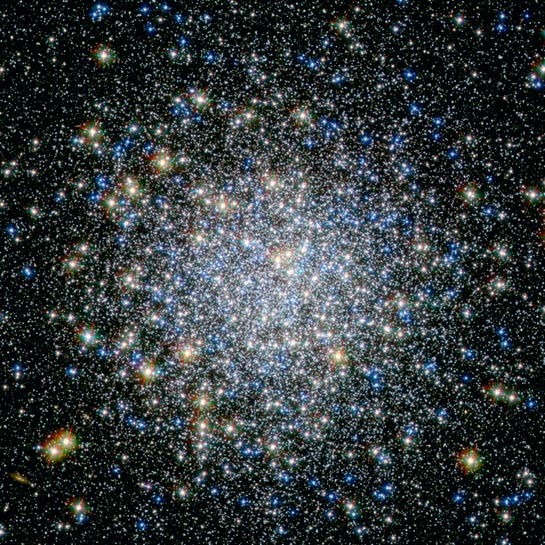
Description: Globular Star Cluster
Position (J2000): RA 15hr 18m 33.22s Dec +02° 04' 51.7"
Constellation: Serpens
Distance: 25000 light years
Image Credit: ESA/Hubble & NASA
Release date: May 2, 2011
Closeup: S1416
ABOUT THIS IMAGE:
The globular cluster Messier 5, shown here in this NASA/ESA Hubble Space Telescope image, is one of the oldest belonging to the Milky Way. The majority of its stars formed more than 12 billion years ago, but there are some unexpected newcomers on the scene, adding some vitality to this aging population.
Stars in globular clusters form in the same stellar nursery and grow old together. The most massive stars age quickly, exhausting their fuel supply in less than a million years, and end their lives in spectacular supernovae explosions. This process should have left the ancient cluster Messier 5 with only old, low-mass stars, which, as they have aged and cooled, have become red giants, while the oldest stars have evolved even further into blue horizontal branch stars.
Yet astronomers have spotted many young, blue stars in this cluster, hiding amongst the much more luminous ancient stars. Astronomers think that these laggard youngsters, called blue stragglers, were created either by stellar collisions or by the transfer of mass between binary stars. Such events are easy to imagine in densely populated globular clusters, in which up to a few million stars are tightly packed together.
Messier
5 lies at a distance of about 25 000 light-years in the constellation
of Serpens (The Snake). This image was taken with Wide Field Channel of
Hubble's Advanced Camera for Surveys. The picture was created from images
taken through a blue filter (F435W, colored blue), a red filter (F625W,
colored green) and a near-infrared filter (F814W, colored red). The total
exposure times per filter were 750 s, 400 s and 567 s, respectively. The
field of view is about 2.6 arcminutes across.